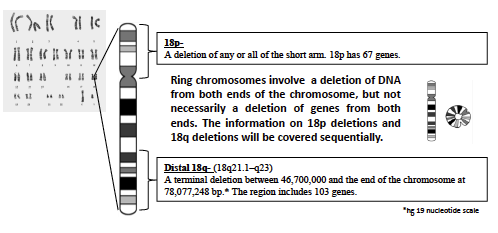Ring 18- Treatment and Surveillance

ICD-10 = Q99.9 or Q93.89
People with Ring 18 have missing material from both ends of the chromosome. However not everyone has genes that are missing from both ends of the chromosome. But the vast majority do have missing genes from both the p arm and the q arm. Each person with Ring 18 has a different combination of 18p and 18q deletions meaning that no two people have the same genetic cause for their medical and developmental issues. In addition, about half of the people with Ring 18 are mosaic for their condition. This means that all of the cells in their body do not have the same genetic make up. The different cells in their body could be completely normal, have one Ring 18, or 2 Ring 18 chromosomes or have only a single copy of chromosome 18. People who are mosaic will also have different levels of mosaicism in different tissues of the body or even within different parts of the same tissue. All these variations make people with Ring 18 a very heterogeneous group.
We have not identified any features in people with Ring 18 that are not also found in people with 18p deletions or 18q deletions. Therefore, in order to provide maximal information on this ultra‐rare condition that occurs on 1 in 300,000 births, we are presenting information, first about 18p deletions then about 18q deletions.
See the downloadable PDF document for the details.
Updated 2020

